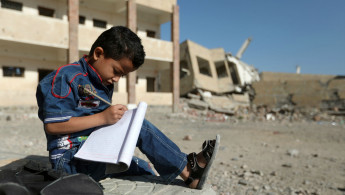One in six children live in a war zone: Save the Children
In a shocking 75 percent increase in the past two decades, there are now more than 350 million children living in conflict impacted areas.
More than half of them, 165 million, live in areas with high intensity conflicts and are subject to severe abuses against children, including sexual violence and child soldier recruitment.
"Children are suffering things that no child ever should; from sexual violence to being used as suicide bombers. Their homes, schools and playgrounds have become battlefields," said Helle Thorning Schmidt, Save the Children CEO.
"This failure to protect children in conflict not only robs them, but also their countries – and the entire world – of a better future."
Since 2010, the killing and maiming of children in conflict has gone up by 300 percent, while incidents of denial of humanitarian access have skyrocketed by more than 1,500 percent. Widespread stigma around rape and sexual assault means figures available are likely to be much higher, a prevalent issue putting girls and boys alike at risk, the report said.
Sometimes, the report finds, the stigma of sexual violence is used by armed forces and groups as a weapon in of itself.
Syrian regime forces reportedly abducted women and girls in groups, releasing them a few days later to their communities and intentionally exposing them as victims of rape.
Children who have been victims of sexual violence are often left with serious physical injuries, which can be particularly severe because their growing bodies are not yet fully developed, the report added.
Brutal tactics are increasingly being used to target children in warfare – including the use of children as suicide bombers, direct targeting of schools and hospitals, and the widespread use of indiscriminate weapons like cluster munitions, barrel bombs and improvised explosive devices.
Part of the reason for the increase in the number of children living in dangerous areas is due to an increasing trend of urban warfare, the report found, plus a recent trend of long and complicated armed conflicts.
Deliberate humanitarian blockades by extremist groups and long-term sieges in countries like Yemen and Syria are also to blame.
Violence in Yemen has pushed some 85,000 people from their homes in the past 10 weeks, with hundreds continuing to flee each day. With more than 22 million people in need of aid, Yemen is the world's largest humanitarian crisis.
| |
| Mutaz, from Yemen, lost his eyesight and was maimed by an explosive he and his cousin found |
The Saudi-led campaign against Yemen includes targeting food supplies and a harsh economic siege, leaving a shocking 8.4 million at risk of famine.
As Yemen's health care system has been brought to the brink of collapse, more than one million people have been infected with cholera, of whom more than 2,000 died, according to the International Committee of the Red Cross.
"Siege tactics and starvation tactics are also increasingly being used as a weapon of war against civilians, to try to force an armed group or whole community to surrender," the report said.
Attacks on hospitals and schools, it said, have become the "new normal".
 |
Children in the Middle East in general were most likely to live in a conflict zone. Two in every five live within 50km of a battle site, or other fatal attack. |  |
"We face a stark choice," Schmidt said. "Will we stand by while more children die at their school desks and in their hospital beds, are denied life-saving aid or are recruited into armed groups? Or will we tackle the culture of impunity and end the 'war on children' for good?"
Syria, Afghanistan and Somalia were ranked as the most dangerous places for children.
Children in the Middle East in general were most likely to live in a conflict zone. Two in every five live within 50km of a battle site, or other fatal attack.
On Wednesday, the UN envoy for Syria warned that this is as "violent and worrying and dangerous" a moment as seen in four years, pointing to escalating violence on multiple fronts that is undermining prospects for peace and threatening regional stability.
In the first week of February alone, fighting over rebel-held Idlib and sustained government airstrikes across the northwest and against the besieged opposition-held Damascus suburb of Eastern Ghouta killed more than 1,000 people.
Recent escalations in places like Myanmar are not fully reflected in the report as data from 2017 is incomplete. The report was released ahead of the Munich Security Conference which begins on Friday.
The charity hopes the conference will provide an opportunity for global leaders to take action to bring in measures to protect children. Last month, gunmen blasted their way into the Afghanistan office, the latest in a series of violence against foreign aid groups in the country, prompting calls that more needs to be done.
The charity has also launched a petition calling on the British foreign secretary Boris Johnson to take action to protect children affected by the war in Yemen.



